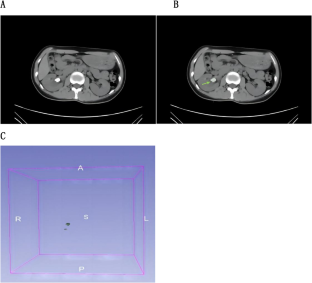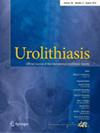开发基于放射组学的机器学习模型,预测经皮肾镜碎石术后的无结石率
摘要
放射组学和机器学习已被广泛应用于泌尿结石领域,尤其是结石治疗结果的预测。本研究旨在整合临床变量和放射组学特征,建立一个机器学习模型,用于预测经皮肾镜取石术(PCNL)后的无石率(SFR)。一项回顾性分析共纳入了212名在南昌大学第二附属医院接受PCNL手术的合格患者。研究人员收集了所有患者的术前临床变量和非对比度增强 CT 图像,并在划定结石 ROI 后提取了放射学特征。通过单变量分析确定与PCNL术后无结石率密切相关的临床变量,并利用最小绝对收缩和选择算子算法(lasso回归)筛选放射学特征。研究采用了四种有监督的机器学习算法,包括逻辑回归(Logistic Regression)、随机森林(Random Forest,RF)、极梯度提升(Extreme Gradient Boosting,XGBoost)和梯度提升决策树(Gradient Boosting Decision Tree,GBDT)。将相关性较强的临床变量和筛选出的放射学特征整合到四种机器学习算法中,构建预测模型,并绘制接收者工作曲线。用接收器工作曲线下面积(AUC)、准确率、特异性等来评价四个模型的预测性能。对术后统计数据进行分析后发现,术后无结石率为 70.3%(n = 149)。在研究的各种临床变量中,结石数量、结石直径、结石 CT 值、结石位置和结石手术史等因素与 PCNL 术后无石率的关系具有统计学意义。共提取了121个放射学特征,通过套索回归,确定了与PCNL术后无石率关系最密切的7个特征。评估了不同模型(逻辑回归、RF、XGBoost 和 GBDT)在确定 PCNL 后无结石率方面的预测准确性,准确率分别为 78.1%、76.6%、75.0% 和 73.4%。相应的曲线下面积 AUC (95%CI) 分别为 0.85 (0.83-0.89)、0.81 (0.76-0.85)、0.82 (0.78-0.85) 和 0.77 (0.73-0.81),使这些模型在逻辑回归预测中名列前茅。就预测重要性得分而言,逻辑回归模型确定的关键因素是结石数量、结石区百分比、结石直径和表面积。同样,RF 模型也将结石数量、结石 CT 值、结石直径和表面积列为最重要的预测因素。在四种机器学习模型中,逻辑回归模型在预测 PCNL 后的无结石率方面表现出了最高的准确性和辨别能力。与 XGBoost 和 GBDT 相比,RF 也表现出更高的准确性和一定的辨别能力。不过,从所有四个模型的表现来看,逻辑回归更有可能帮助临床医生诊断患者的 PCNL,从而有助于临床决策。这使我们能够有效预测手术后是否存在残余结石,并最终选择适合 PCNL 的患者。

Radiomics and machine learning have been extensively utilized in the realm of urinary stones, particularly in forecasting stone treatment outcomes. The objective of this study was to integrate clinical variables and radiomic features to develop a machine learning model for predicting the stone-free rate (SFR) following percutaneous nephrolithotomy (PCNL). A total of 212 eligible patients who underwent PCNL surgery at the Second Affiliated Hospital of Nanchang University were included in a retrospective analysis. Preoperative clinical variables and non-contrast-enhanced CT images of all patients were collected, and radiomic features were extracted after delineating the stone ROI. Univariate analysis was conducted to identify clinical variables strongly correlated with the stone-free rate after PCNL, and the least absolute shrinkage and selection operator algorithm (lasso regression) was utilized to screen radiomic features. Four supervised machine learning algorithms, including Logistic Regression, Random Forest (RF), Extreme Gradient Boosting (XGBoost), and Gradient Boosting Decision Tree (GBDT), were employed. The clinical variables with strong correlation and screened radiomic features were integrated into the four machine learning algorithms to construct a prediction model, and the receiver operating curve was plotted. The area under the receiver operating curve (AUC), the accuracy rate, the specificity, etc., were used to evaluate the predictive performance of the four models. After analyzing postoperative statistics, the stone-free rate following the procedure was found to be 70.3% (n = 149). Among the various clinical variables examined, factors, such as stone number, stone diameter, stone CT value, stone location, and history of stone surgery, were identified as statistically significant in relation to the stone-free rate after PCNL. A total of 121 radiomic features were extracted, and through lasso regression, 7 features most closely associated with the stone-free rate post-PCNL were identified. The predictive accuracy of different models (Logistic Regression, RF, XGBoost, and GBDT) for determining the stone-free rate after PCNL was evaluated, yielding accuracies of 78.1%, 76.6%, 75.0%, and 73.4%, respectively. The corresponding area under the curve AUC (95%CI) were 0.85 (0.83–0.89), 0.81 (0.76–0.85), 0.82 (0.78–0.85), and 0.77 (0.73–0.81), positioning these models among the top performers in logistic regression prediction. In terms of predictive importance scores, the key factors identified by the logistic regression model were number of stone, zone percentage, stone diameter, and surface area. Similarly, the RF model highlighted number of stone, stone CT value, stone diameter, and surface area as the top predictors. Among the four machine learning models, the logistic regression model demonstrated the highest accuracy and discrimination ability in predicting the stone-free rate following PCNL. In comparison to XGBoost and GBDT, RF also exhibited superior accuracy and a certain level of discrimination ability. However, based on the performance of all four models, logistic regression is more likely to aid in clinical decision-making by assisting clinicians in diagnosing PCNL in patients. This enables us to effectively predict the presence of residual stones post-surgery and ultimately select patients who are suitable candidates for PCNL.

 求助内容:
求助内容: 应助结果提醒方式:
应助结果提醒方式:


